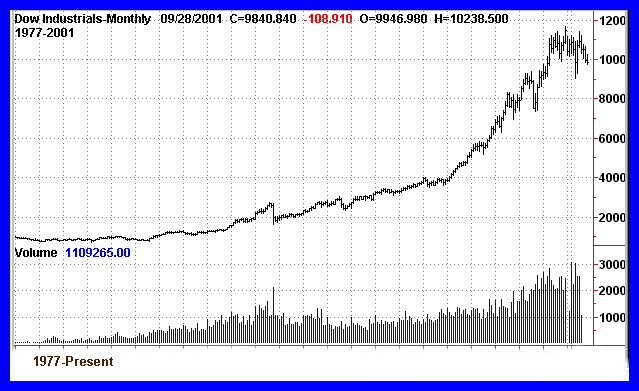Today’sTrading Lesson From TradingMarkets
Editor’s Note:
Each night we feature a different lesson from
TM University. I hope you enjoy and profit from these.
E-mail me if you have
any questions.
Brice
Â
How To Time The Market — Without Market Timing
Â
Being on the right side of the market is how
investors can consistently grow capital in good times, and protect capital from
being on the wrong side of the trend. Let me reiterate that I manage money using
two simple methods of allocation: either investing in stocks, or investing in
treasuries (money market). The best part about what I do is not trying to “timeâ€
the market. This style of investing has worked well for me, and the U.S. stock
market and economy continually offer unprecedented opportunities for growth,
with brief pauses now and again.
Take the following
chart for example, even the dips throughout history don’t take away from the
long-term trend.

Market timing is
often confused with having a sound discipline telling an investor when a stock
should be bought or strict rules on when a stock should be sold. Naturally, once
these rules are in place, there will be times when the search goes on for stocks
to buy because none are fulfilling the entire buy criteria. Likewise, at the
same time there are no stocks to buy, sell rules have forced the liquidation of
recent holdings and inevitably, the portfolio ends up entirely in cash.
The point of this lesson is to expand on my first lesson:
Here’s The Checklist I Use Before I Buy Any
Stock. I intend to
offer the same structure in terms of a Sell checklist, in order to sell
positions in order to minimize losses and maximize gains.
To recap on where we
left off in the previous lesson, I begin the process with evaluating the overall
health of the market that Mr. William O’Neil has introduced to the investing
public. By gauging the accumulation or distribution, I solve
only one piece of the investing puzzle. As
the market shows signs of accumulation for a brief period (seven days or less to
be exact), I begin to stalk new stock purchases. A market-timing model would
simply respond to the market and require action. In my analysis, the market
action is only an “all-clear†to buy stocks that fulfill a regimented list of
rules. These rules include
strict EPS growth guidelines, industry group
strength, strength in the stock’s price performance, strength
in the company, etc.
Once stocks have
appreciated in a portfolio, it becomes time to watch them for signs of trouble.
Ninety-nine percent of the time, leading stocks will flash
trouble signs such as
new highs on low volume, climax run,
no forward price progress on increasing volume and so on before
the major market indices flash a warning. This is the time when strict sell
rules come into play. These are the second half of the investment puzzle in
order to maximize the gains in a portfolio. As stocks flash warning signs that
they may be topping, they should be sold. Likewise, the market flashing signs of
distribution should also call for at least a partial liquidation. So it comes
time to define these “sell rules†so that it becomes a mechanical process on
when it is time to liquidate a position.
Beginning this is
always the hardest part. I believe a gut feeling is the best thing to use in
finding a starting point. Investors, myself included, know where they run into
trouble selling stocks. I began the process by looking back at all my past
trades and simply pulling up charts on them and spotting the ideal sell points
that would have netted the most profit. The next step is to look closer at the
chart and identify signs of trouble the stock portrayed before topping.
After my
post-analysis and sell-rule statements, I simply went back to charts of winning
stocks and applied the rules. In effect, this “tested†my rules and allowed me
to see that my specific rules would handle each and every situation allowing me
to the best of my knowledge
make the most amount of money possible on each and every
trade.
Once again, I could
have printed my list here, but I feel it is the necessary step for each investor
to create a list for themselves, that fits their investing personality. I will
go on to state the sell signs my list encompasses including the format I use. A
checklist such as this should also be stated in a way that forces each of us to
realize that if 1 criteria has been met, it gets checked and the stock gets
sold.
I will start this list off with my Rule #1:
-
7-8% from actual
buy pointNow on to the other points which a sell list should cover:
Â
-
Stock moving up
without volume and a lack of sellers -
Climax Top as stock will most likely
fall hard once this begins -
Heavy volume without further price
progress upward -
After being purchased, a stock moves
much higher, then starts returning to the original buy point; (this should
never turn into a loss!) -
Decelerating earnings in a company or
declining fundamentals -
Market appears to be under
distribution, (most stocks, no matter how great they seem, will follow the
market) -
Stock breaks out of short base, or is
not supported by volume on a breakout
By following simple
rules such as these points, investors will find themselves mechanically
liquidating stocks before the market falls
apart. And as we wade through the recent Bear market, we all know that very few
stocks appear qualified under a buy list. This is how a portfolio becomes
“protected” in a cash position without trying to “time the market.â€
For more information
and details on compiling the entire money management and investing picture, I
welcome your emails.
Good luck and great
trading!
